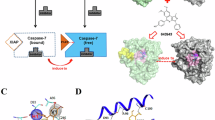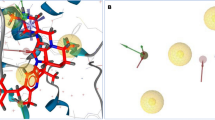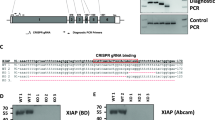Abstract
Deregulation of apoptotic pathways plays a central role in cancer pathogenesis. X-linked inhibitor of apoptosis protein (XIAP), is an antiapoptotic molecule, whose elevated expression has been observed in tumor specimens from patients with prostate carcinoma. Studies in human cancer cell culture models and xenograft tumor models have demonstrated that loss of XIAP sensitizes cancer cells to apoptotic stimuli and abrogates tumor growth. In view of these findings, XIAP represents an attractive antiapoptotic therapeutic target for prostate cancer. To examine the role of XIAP in an immunocompetent mouse cancer model, we have generated transgenic adenocarcinoma of the mouse prostate (TRAMP) mice that lack XIAP. We did not observe a protective effect of Xiap deficiency in TRAMP mice as measured by tumor onset and overall survival. In fact, there was an unexpected trend toward more aggressive disease in the Xiap-deficient mice. These findings suggest that alternative mechanisms of apoptosis resistance are playing a significant oncogenic role in the setting of Xiap deficiency. Our study has implications for XIAP-targeting therapies currently in development. Greater understanding of these mechanisms will aid in combating resistance to XIAP-targeting treatment, in addition to optimizing selection of patients who are most likely to respond to such treatment.
Similar content being viewed by others
Log in or create a free account to read this content
Gain free access to this article, as well as selected content from this journal and more on nature.com
or
Abbreviations
- c-IAP1:
-
cellular inhibitor of apoptosis protein 1
- c-IAP2:
-
cellular inhibitor of apoptosis protein 2
- IAP:
-
inhibitor of apoptosis protein
- MRI:
-
magnetic resonance imaging
- PIN:
-
prostatic intraepithelial neoplasia
- RIAP:
-
rodent inhibitor of apoptosis protein
- TRAMP:
-
transgenic adenocarcinoma of mouse prostate
- TUNEL:
-
terminal dUTP nick end labeling
- XIAP:
-
X-linked inhibitor of apoptosis protein
References
Hanahan D, Weinberg RA . The hallmarks of cancer. Cell 2000; 100: 57–70.
Green DR, Evan GI . A matter of life and death. Cancer Cell 2002; 1: 19–30.
Nunez G, Benedict MA, Hu Y, Inohara N . Caspases: the proteases of the apoptotic pathway. Oncogene 1998; 17: 3237–3245.
Shiozaki EN, Shi Y . Caspases, IAPs and Smac/DIABLO: mechanisms from structural biology. Trends Biochem Sci 2004; 29: 486–494.
Vaux DL, Silke J . IAPs, RINGs and ubiquitylation. Nat Rev Mol Cell Biol 2005; 6: 287–297.
Deveraux QL, Takahashi R, Salvesen GS, Reed JC . X-linked IAP is a direct inhibitor of cell-death proteases. Nature 1997; 388: 300–304.
LaCasse EC, Baird S, Korneluk RG, MacKenzie AE . The inhibitors of apoptosis (IAPs) and their emerging role in cancer. Oncogene 1998; 17: 3247–3259.
Holcik M, Gibson H, Korneluk RG . XIAP: apoptotic brake and promising therapeutic target. Apoptosis 2001; 6: 253–261.
Schimmer AD, Dalili S, Batey RA, Riedl SJ . Targeting XIAP for the treatment of malignancy. Cell Death Differ 2006; 13: 179–188.
Jaffer S, Orta L, Sunkara S, Sabo E, Burstein DE . Immunohistochemical detection of antiapoptotic protein X-linked inhibitor of apoptosis in mammary carcinoma. Hum Pathol 2007; 38: 864–870.
Kluger HM, McCarthy MM, Alvero AB, Sznol M, Ariyan S, Camp RL et al. The X-linked inhibitor of apoptosis protein (XIAP) is up-regulated in metastatic melanoma, and XIAP cleavage by phenoxodiol is associated with carboplatin sensitization. J Transl Med 2007; 5: 6.
Krajewska M, Krajewski S, Banares S, Huang X, Turner B, Bubendorf L et al. Elevated expression of inhibitor of apoptosis proteins in prostate cancer. Clin Cancer Res 2003; 9: 4914–4925.
Lopes RB, Gangeswaran R, McNeish IA, Wang Y, Lemoine NR . Expression of the IAP protein family is dysregulated in pancreatic cancer cells and is important for resistance to chemotherapy. Int J Cancer 2007; 120: 2344–2352.
Mizutani Y, Nakanishi H, Li YN, Matsubara H, Yamamoto K, Sato N et al. Overexpression of XIAP expression in renal cell carcinoma predicts a worse prognosis. Int J Oncol 2007; 30: 919–925.
Tamm I, Richter S, Oltersdorf D, Creutzig U, Harbott J, Scholz F et al. High expression levels of X-linked inhibitor of apoptosis protein and survivin correlate with poor overall survival in childhood de novo acute myeloid leukemia. Clin Cancer Res 2004; 10: 3737–3744.
Tamm I, Kornblau SM, Segall H, Krajewski S, Welsh K, Kitada S et al. Expression and prognostic significance of IAP-family genes in human cancers and myeloid leukemias. Clin Cancer Res 2000; 6: 1796–1803.
Berezovskaya O, Schimmer AD, Glinskii AB, Pinilla C, Hoffman RM, Reed JC et al. Increased expression of apoptosis inhibitor protein XIAP contributes to anoikis resistance of circulating human prostate cancer metastasis precursor cells. Cancer Res 2005; 65: 2378–2386.
Holcik M, Yeh C, Korneluk RG, Chow T . Translational upregulation of X-linked inhibitor of apoptosis (XIAP) increases resistance to radiation induced cell death. Oncogene 2000; 19: 4174–4177.
Liu Z, Li H, Derouet M, Filmus J, LaCasse EC, Korneluk RG et al. ras oncogene triggers up-regulation of cIAP2 and XIAP in intestinal epithelial cells: epidermal growth factor receptor-dependent and -independent mechanisms of ras-induced transformation. J Biol Chem 2005; 280: 37383–37392.
Liu Z, Li H, Wu X, Yoo BH, Yan SR, Stadnyk AW et al. Detachment-induced upregulation of XIAP and cIAP2 delays anoikis of intestinal epithelial cells. Oncogene 2006; 25: 7680–7690.
Ng CP, Bonavida B . X-linked inhibitor of apoptosis (XIAP) blocks Apo2 ligand/tumor necrosis factor-related apoptosis-inducing ligand-mediated apoptosis of prostate cancer cells in the presence of mitochondrial activation: sensitization by overexpression of second mitochondria-derived activator of caspase/direct IAP-binding protein with low pl (Smac/DIABLO). Mol Cancer Ther 2002; 1: 1051–1058.
Nomura T, Mimata H, Takeuchi Y, Yamamoto H, Miyamoto E, Nomura Y . The X-linked inhibitor of apoptosis protein inhibits taxol-induced apoptosis in LNCaP cells. Urol Res 2003; 31: 37–44.
Amantana A, London CA, Iversen PL, Devi GR . X-linked inhibitor of apoptosis protein inhibition induces apoptosis and enhances chemotherapy sensitivity in human prostate cancer cells. Mol Cancer Ther 2004; 3: 699–707.
LaCasse EC, Cherton-Horvat GG, Hewitt KE, Jerome LJ, Morris SJ, Kandimalla ER et al. Preclinical characterization of AEG35156/GEM 640, a second-generation antisense oligonucleotide targeting X-linked inhibitor of apoptosis. Clin Cancer Res 2006; 12: 5231–5241.
McManus DC, Lefebvre CA, Cherton-Horvat G, St-Jean M, Kandimalla ER, Agrawal S et al. Loss of XIAP protein expression by RNAi and antisense approaches sensitizes cancer cells to functionally diverse chemotherapeutics. Oncogene 2004; 23: 8105–8117.
Ferreira CG, van der Valk P, Span SW, Ludwig I, Smit EF, Kruyt FA et al. Expression of X-linked inhibitor of apoptosis as a novel prognostic marker in radically resected non-small cell lung cancer patients. Clin Cancer Res 2001; 7: 2468–2474.
Greenberg NM, DeMayo F, Finegold MJ, Medina D, Tilley WD, Aspinall JO et al. Prostate cancer in a transgenic mouse. Proc Natl Acad Sci USA 1995; 92: 3439–3443.
Bilim V, Kasahara T, Hara N, Takahashi K, Tomita Y . Role of XIAP in the malignant phenotype of transitional cell cancer (TCC) and therapeutic activity of XIAP antisense oligonucleotides against multidrug-resistant TCC in vitro. Int J Cancer 2003; 103: 29–37.
Eckelman BP, Salvesen GS . The human anti-apoptotic proteins cIAP1 and cIAP2 bind but do not inhibit caspases. J Biol Chem 2006; 281: 3254–3260.
Harlin H, Reffey SB, Duckett CS, Lindsten T, Thompson CB . Characterization of XIAP-deficient mice. Mol Cell Biol 2001; 21: 3604–3608.
Yang Y, Fang S, Jensen JP, Weissman AM, Ashwell JD . Ubiquitin protein ligase activity of IAPs and their degradation in proteasomes in response to apoptotic stimuli. Science 2000; 288: 874–877.
Marienfeld C, Yamagiwa Y, Ueno Y, Chiasson V, Brooks L, Meng F et al. Translational regulation of XIAP expression and cell survival during hypoxia in human cholangiocarcinoma. Gastroenterology 2004; 127: 1787–1797.
Cummins JM, Kohli M, Rago C, Kinzler KW, Vogelstein B, Bunz F . X-linked inhibitor of apoptosis protein (XIAP) is a nonredundant modulator of tumor necrosis factor-related apoptosis-inducing ligand (TRAIL)-mediated apoptosis in human cancer cells. Cancer Res 2004; 64: 3006–3008.
Ravi R, Fuchs EJ, Jain A, Pham V, Yoshimura K, Prouser T et al. Resistance of cancers to immunologic cytotoxicity and adoptive immunotherapy via X-linked inhibitor of apoptosis protein expression and coexisting defects in mitochondrial death signaling. Cancer Res 2006; 66: 1730–1739.
Arnt CR, Chiorean MV, Heldebrant MP, Gores GJ, Kaufmann SH . Synthetic Smac/DIABLO peptides enhance the effects of chemotherapeutic agents by binding XIAP and cIAP1 in situ. J Biol Chem 2002; 277: 44236–44243.
Sasaki H, Sheng Y, Kotsuji F, Tsang BK . Down-regulation of X-linked inhibitor of apoptosis protein induces apoptosis in chemoresistant human ovarian cancer cells. Cancer Res 2000; 60: 5659–5666.
Schimmer AD, Welsh K, Pinilla C, Wang Z, Krajewska M, Bonneau MJ et al. Small-molecule antagonists of apoptosis suppressor XIAP exhibit broad antitumor activity. Cancer Cell 2004; 5: 25–35.
Bruckheimer EM, Brisbay S, Johnson DJ, Gingrich JR, Greenberg N, McDonnell TJ . Bcl-2 accelerates multistep prostate carcinogenesis in vivo. Oncogene 2000; 19: 5251–5258.
Gupta S, Hastak K, Ahmad N, Lewin JS, Mukhtar H . Inhibition of prostate carcinogenesis in TRAMP mice by oral infusion of green tea polyphenols. Proc Natl Acad Sci USA 2001; 98: 10350–10355.
Gupta S, Adhami VM, Subbarayan M, MacLennan GT, Lewin JS, Hafeli UO et al. Suppression of prostate carcinogenesis by dietary supplementation of celecoxib in transgenic adenocarcinoma of the mouse prostate model. Cancer Res 2004; 64: 3334–3343.
Tenev T, Zachariou A, Wilson R, Ditzel M, Meier P . IAPs are functionally non-equivalent and regulate effector caspases through distinct mechanisms. Nat Cell Biol 2005; 7: 70–77.
Yang L, Cao Z, Yan H, Wood WC . Coexistence of high levels of apoptotic signaling and inhibitor of apoptosis proteins in human tumor cells: implication for cancer specific therapy. Cancer Res 2003; 63: 6815–6824.
Acknowledgements
We thank Drs. Peter Liston and Robert Korneluk for the generous gift of RIAP antibody, Dr. Guy Salvesen for his gift of caspase-3 antibody and Drs. Brian Ross and Brad Moffat for their assistance with MRI imaging. KO is a recipient of a Pre-doctoral Award funded through the Breast Cancer Research Program of the Department of Defense (W81XWH-06-1-0429). This study was supported by funding received from the Department of Defense (W81XWH-04-1-0891) and the National Institutes of Health (5R01GM067827-03). Dr. Colin Duckett serves as a consultant to Aegera Therapeutics and is a member of their scientific advisory board. All other authors have no conflicting interests.
Author information
Authors and Affiliations
Corresponding author
Additional information
Edited by A Villunger
Rights and permissions
About this article
Cite this article
Hwang, C., Oetjen, K., Kosoff, D. et al. X-linked inhibitor of apoptosis deficiency in the TRAMP mouse prostate cancer model. Cell Death Differ 15, 831–840 (2008). https://doi.org/10.1038/cdd.2008.15
Received:
Revised:
Accepted:
Published:
Issue date:
DOI: https://doi.org/10.1038/cdd.2008.15
Keywords
This article is cited by
-
Increased migration and motility in XIAP-null cells mediated by the C-RAF protein kinase
Scientific Reports (2022)
-
Pim-2 Cooperates with Downstream Factor XIAP to Inhibit Apoptosis and Intensify Malignant Grade in Prostate Cancer
Pathology & Oncology Research (2019)
-
Prognostic value of inhibitors of apoptosis proteins (IAPs) and caspases in prostate cancer: caspase-3 forms and XIAP predict biochemical progression after radical prostatectomy
BMC Cancer (2015)
-
IAPs on the move: role of inhibitors of apoptosis proteins in cell migration
Cell Death & Disease (2013)
-
IAPs regulate the plasticity of cell migration by directly targeting Rac1 for degradation
The EMBO Journal (2012)



